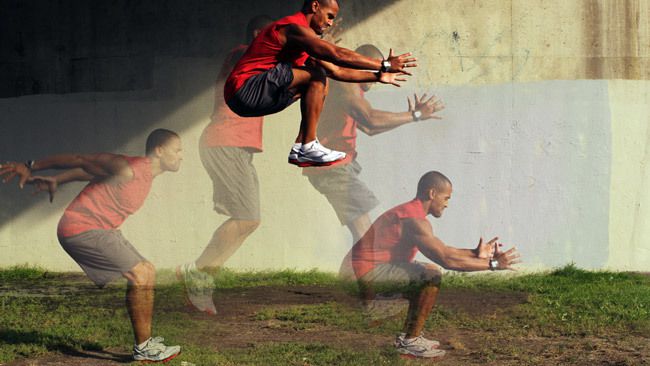Introduction
This blog will thoroughly analyse plyometric training, its effect of football and its application.
What is it?
Plyometric training is a method of conditioning which involves explosive exercises (Gabriel et al. 2011). Usually involving bodyweight, these specific exercises aim to utilise the stretch shortening cycle (ssc) to increase maximal power output, a key attribute needed for any footballer (Markovic and Mikulic, 2010). Exercises that can be performed include: Jumps, hop and holds, hurdle work etc.
Why is this method used?
Plyometric training is a method of training which is widely adopted within football training and conditioning. Within football, players are required to perform explosive actions such as sprinting, jumping, turning, kicking etc. To this regard, power production from the lower limbs is an essential fitness component for any footballer (Wisloff et al. 2004).
Below are photos showing various plyometric exercises which use explosive power within the lower limbs
Box Jumps

Hurdle Jumps/hops

Squat Jumps
When engaging in plyometric exercises the stretch shortening cycle plays a pivotal role (Komi, 2008), this involving the lengthening on the muscle eccentrically before an immediate powerful concentric contraction. Research by Luebbers et al. (2003) found that performance improved when plyometric exercises used the stretch shortening cycle, this particularly within the concentric phase (e.g the up phase in a jump).
Variations of plyometric training
Having identified the beneficial use of plyometrics especially for footballers, it is therefore essential that training focuses on enhancing explosive power from the lower limbs to aid kicking, jumping turning etc. (Ronnestad et al. 2008). Further, when wanting to manipulate training to focus on specific fitness components such as power, strength and speed Impellizzeri et al. (2008) discusses how different surfaces can aid such performance outcomes, e.g sand. In addition, performing these exercises on varied surfaces such as sand found reduction in muscle soreness when compared to grass.
Below is a video showing plyometric exercises being performed on sand.
Adaptations of plyometric training
Research has discussed various ways in which this type of training can be adapted. One method discussed was the idea of combining plyometric training and weight lifting in order to get the best outcome. Further, Perez-Gomez et al. (2008) found that although this combination is beneficial in improving vertical jump height and 1RM force, it does however show no indication that it has an effect on running velocity.
Below is a video showing how plyometric training can be combined with weights.
Research and limitations
Whilst research suggests that plyometric training is beneficial for footballers it is however uncertain as to what the most effective method of training is with relation to another training method (e.g. weightlifting).
This would therefore imply the need to further research this area to aid coaches and their application of such training in the future.
References
GABRIEL, M., LAURENTIU-GABRIEL, T., CLAUDIU, M., and MIHAELA, I. T., 2011. Study regarding use of plyometrics means in training process of junior footballers at 16-18 years. Physical Education & Sport Management. (2).
IMPELLIZZERI, F. M., RAMPININI, E., CASTAGNA, C., BISHOP, D., FERRARI BRAVO, D., TIBAUDI, A., and WISLOFF, U., 2008. Validity of a repeated-sprint test for football. International journal of sports medicine. 29(11), pp.899.
KOMI, P. V. 2008. Stretch-shortening cycle. Strength and power in sport. 2, pp. 184-202.
LUEBBERS, P. E., POTTEIGER, J. A., HULVER, M. W., THYFAULT, J. P., CARPER, M. J., & LOCKWOOD, R. H. 2003. Effects of plyometric training and recovery on vertical jump performance and anaerobic power. The Journal of Strength & Conditioning Research. 17(4), 704-709.
MARKOVIC, G., & MIKULIC, P. 2010. Neuro-musculoskeletal and performance adaptations to lower-extremity plyometric training. Sports medicine. 40(10), 859-895.
PEREZ-GOMEZ, J., OLMEDILLAS, H., DALGADO-GUERRA, S., ROYO, I. A., VICENTE-RODRIGUEZ, G., ORTIZ, R. A., and CALBET, J. A., 2008. Effects of weight lifting training combined with plyometric exercises on physical fitness, body composition, and knee extension velocity during kicking in football. Applied Physiology, Nutrition, and Metabolism. 33(3), pp.501-510.
RONNESTAD, B. R., KVAMME, N. H., SUNDE, A., and RAASTAD, T., 2008. Short-term effects of strength and plyometric training on sprint and jump performance in professional soccer players. The Journal of Strength & Conditioning Research. 22(3), pp.773-780.
WISLOFF, U., CASTAGNA, C., HELGERUD, J., JONES, R., and HOFF, J., 2004. Strong correlation of maximal squat strength with sprint performance and vertical jump height in elite soccer players. British journal of sports medicine. 38(3), pp.285-288.


Leave a comment